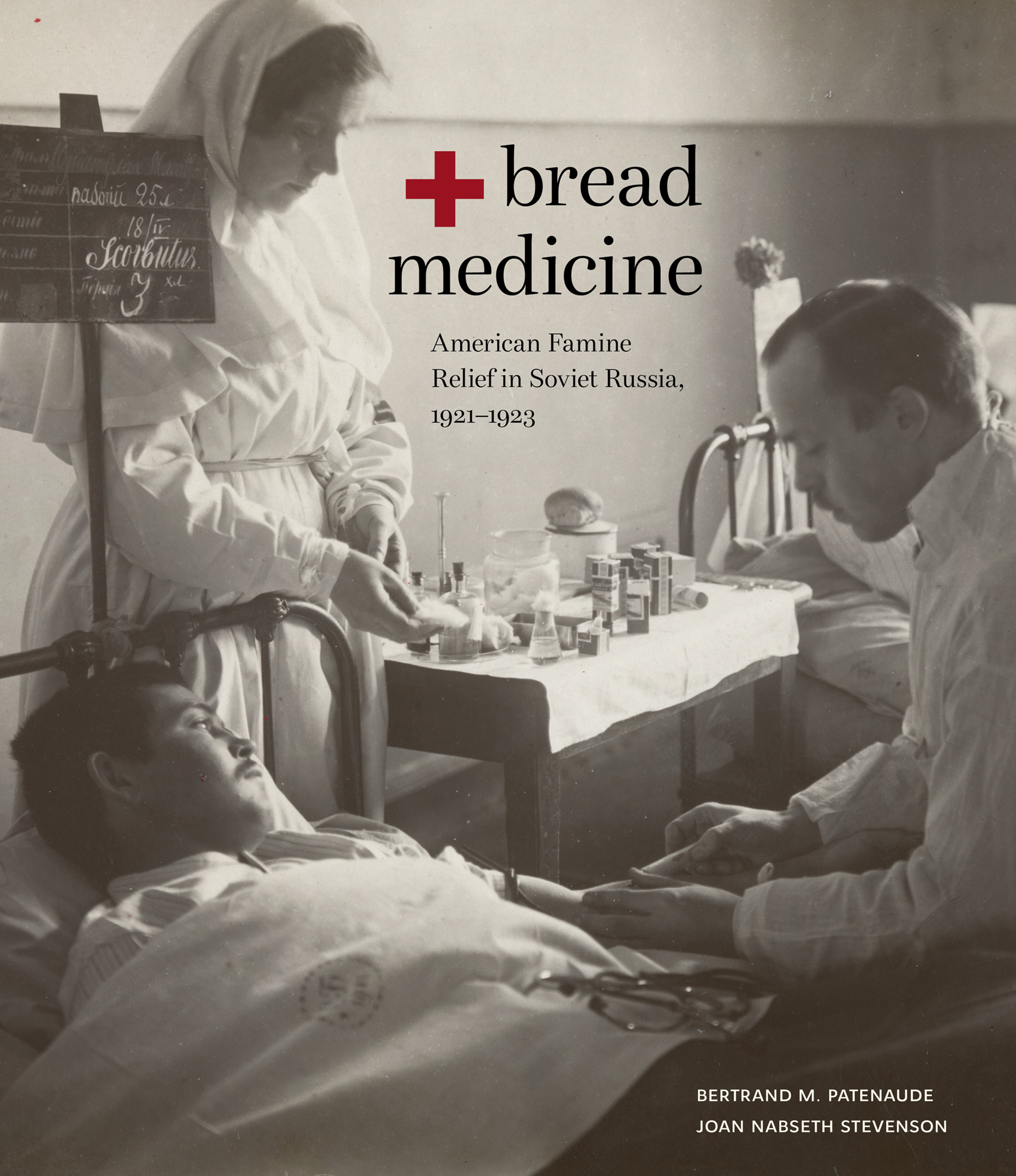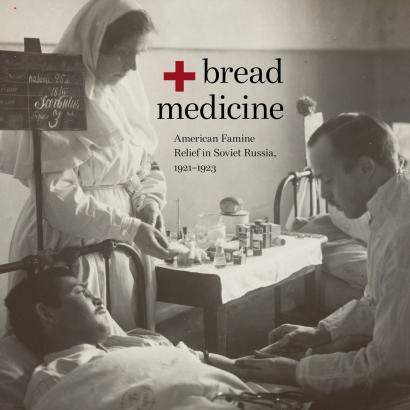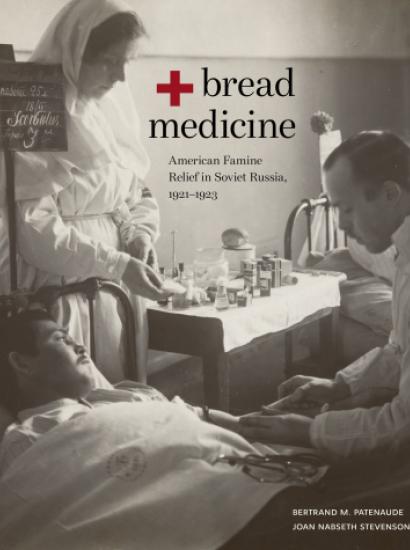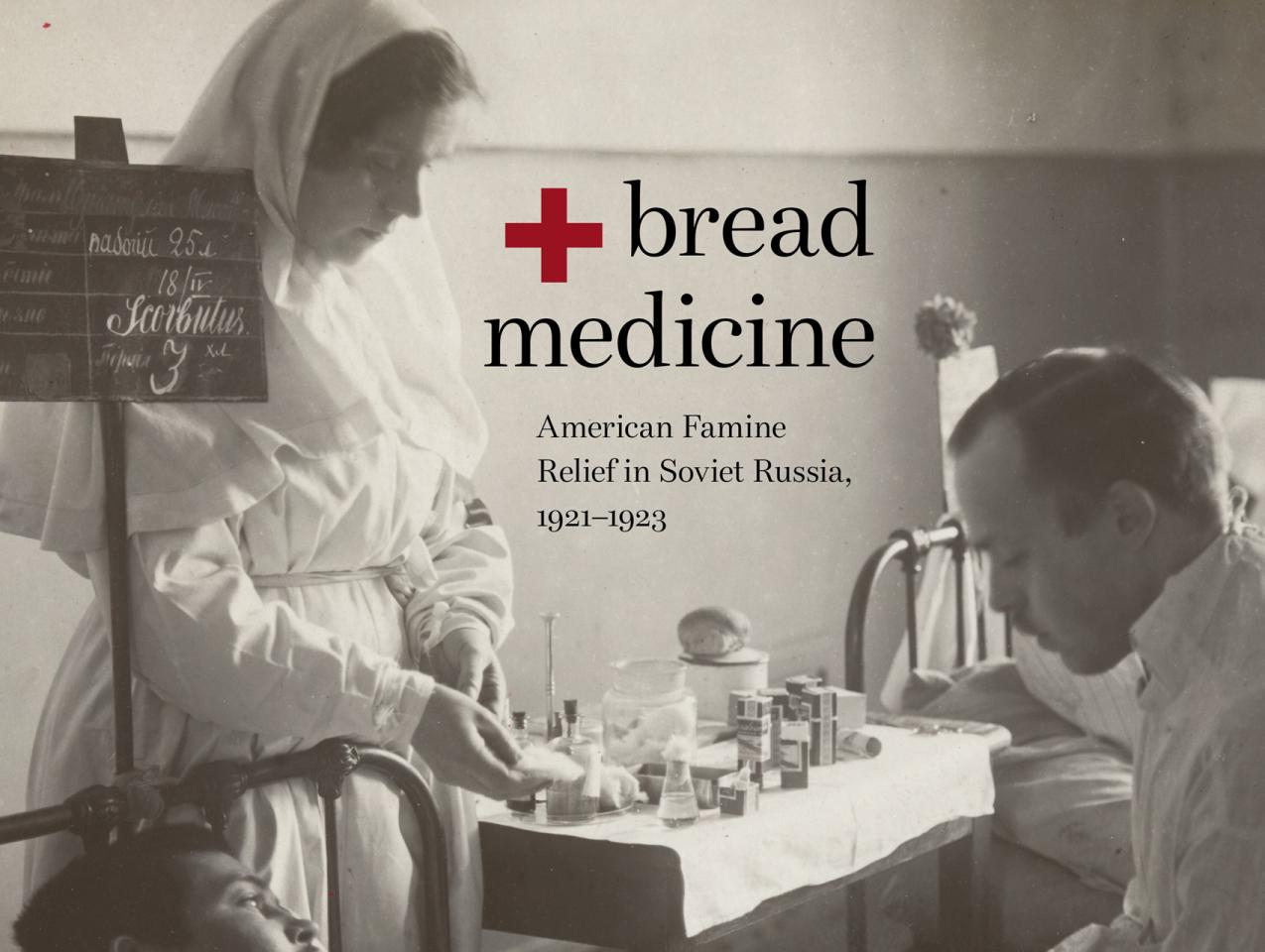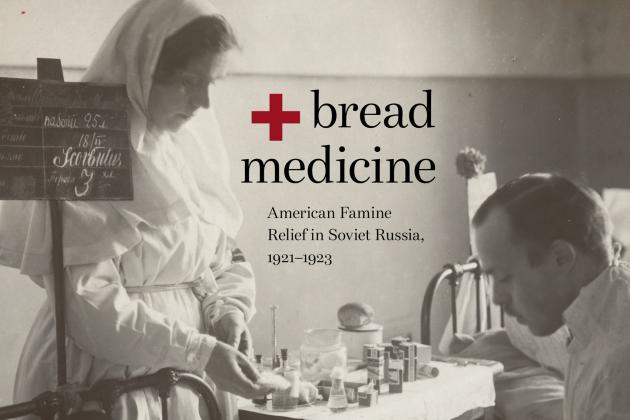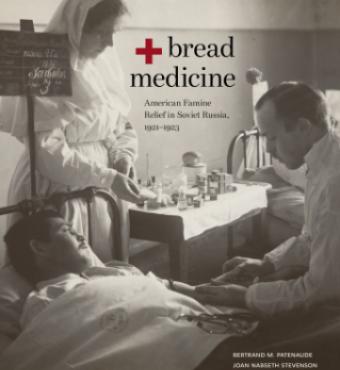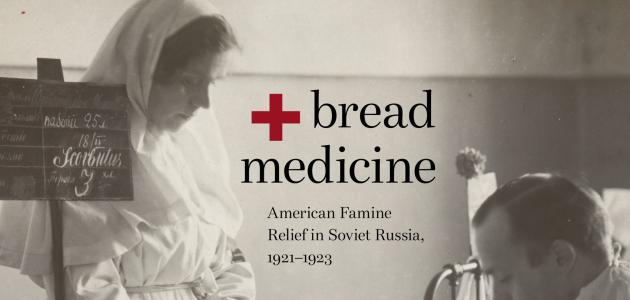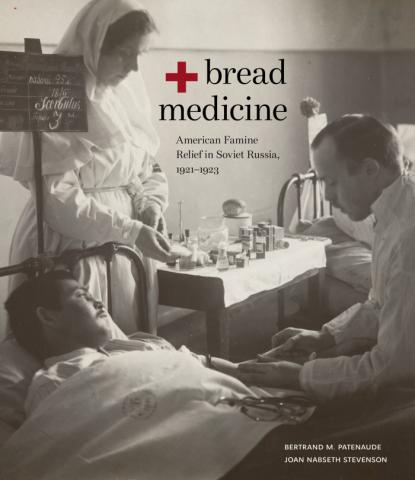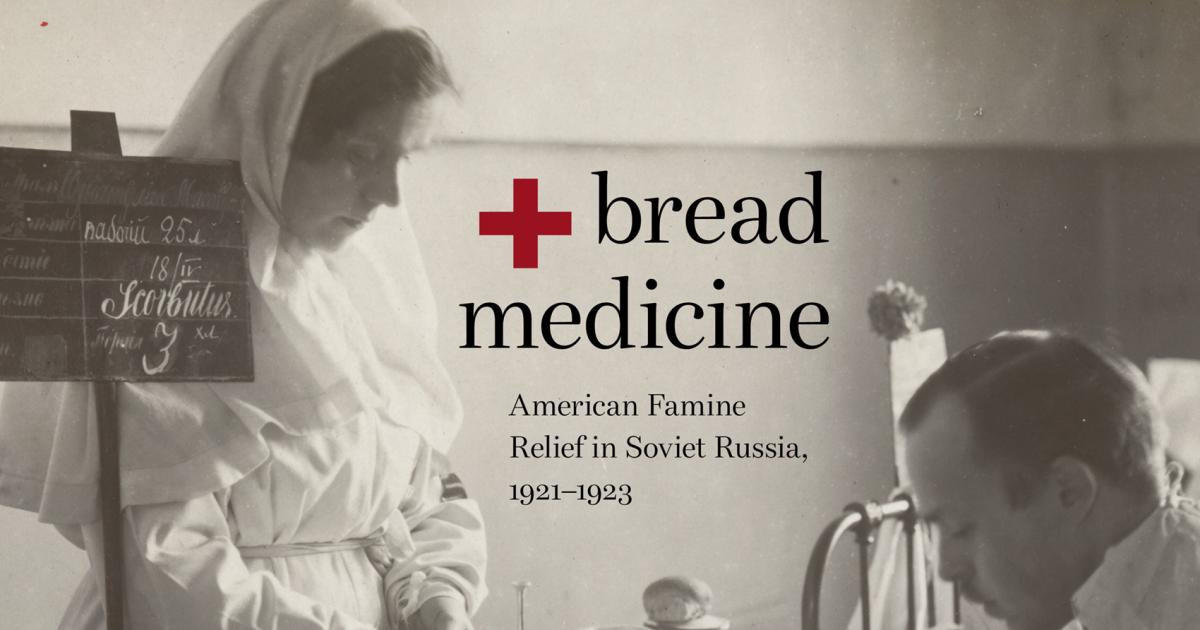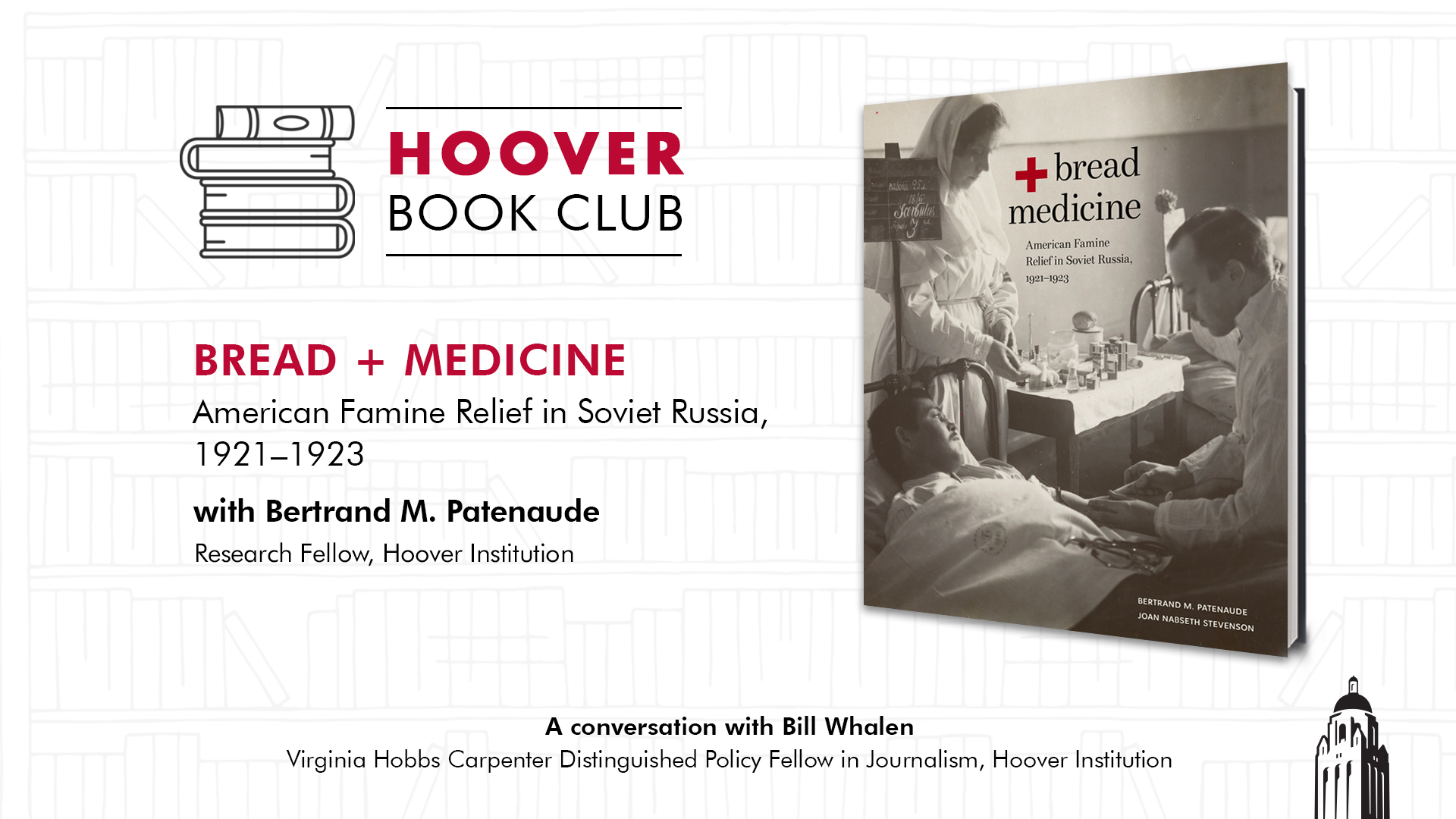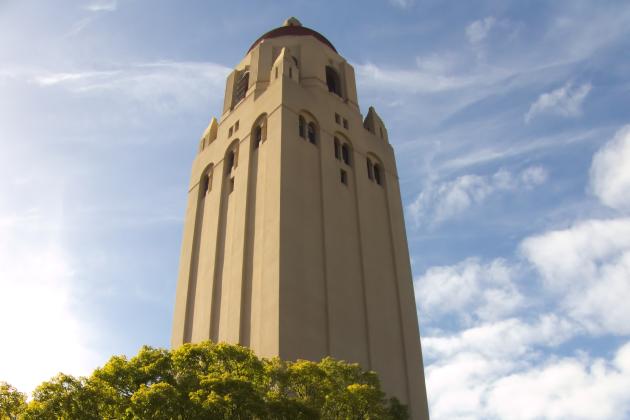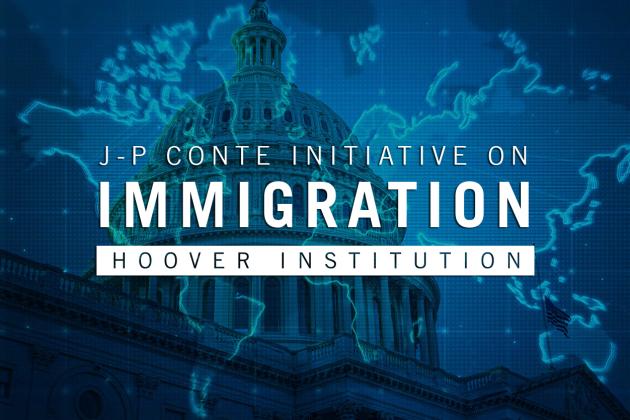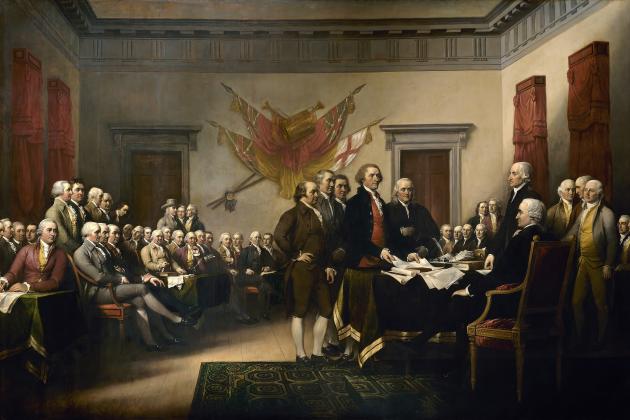Join the Hoover Book Club for engaging discussions with leading authors on the hottest policy issues of the day. Hoover scholars explore the latest books that delve into some of the most vexing policy issues facing the United States and the world. Find out what makes these authors tick and how they think we should approach our most difficult challenges.
In our latest installment, watch a discussion between Bill Whalen, the Virginia Hobbs Carpenter Distinguished Policy Fellow in Journalism and Bertrand M. Patenaude, a research fellow and author of the recently released Hoover Institution Press book Bread + Medicine: American Famine Relief in Soviet Russia, 1921–1923 on Thursday, June 1, 2023 at 10:00 am PT/ 1:00pm ET.
WATCH HERE
>> Bill Whalen: Hello, I'm Bill Whalen. I'm the Hoover Institution's Virginia Hobbs Carpenter Distinguished Policy Fellow in Journalism. And I'd like to welcome you back to the Hoover Book Club, where we bring Hoover fellows and friends together to discuss their latest writings. Our guest today is Bert Patenaude. Bert is a research fellow here at the Hoover Institution and a lecturer in history and international relations at Stanford University.
He is the author of several books, including The Big Show in Bololand: The American Relief Expedition to Soviet Russia in the Famine of 1921, which won the 2003 Marshall Shulman Book Prize and was the basis of a PBS documentary film broadcast. His 2009 book, Trotsky: Downfall of a Revolutionary, published by HarperCollins, was serialized for radio by BBC.
Bert has published two books on the century-long history of the Hoover Institution, A Wealth of Ideas: Revelations from the Hoover Institution Archives, and Defining Moments, the First One Hundred Years of the Hoover Institution. These are both generously illustrated large format books. They feature rare documents, photographs, posters and artifacts from the Hoover Institution's Library and Archives.
That is a very long way of saying it makes a great coffee table book, if you'd like to have those sorts of decorations. Bert Patenaude joins us today to discuss a book he's co-authored that he's recently released, Bread + Medicine: American Famine Relief in Soviet Russia, 1921-1923. Bert, welcome to the Hoover Book Club.
>> Bertrand Patenaude: Bill, great to be on the show. Thanks for having me here, and to talk about Bread and Medicine and those other books, maybe, that you mentioned in that generous intro.
>> Bill Whalen: And let's do that cuz they all tie together. But first, I'd like to talk a little bit about the Hoover archives, or as we like to call them, L&A, the Library and Archives.
It's interesting in this regard, I think, Bert. The Hoover Institution has a history of tradition of very public faces. Our director is Condoleezza Rice. We were graced for decades by the presence of the great George Schultz, Milton Friedman, very public figures, very renowned figures. The Hoover Tower on the Stanford campus, Bert, it is the most visible landmark at Stanford University.
And yet we have this vast treasure trove that is our library and archives literally hidden inside the Hoover Institution, not a lot of people know about. Let's talk a bit about L&A. So just explain to people what exactly archives are and how it ties into the historical mission of the Hoover Institution.
>> Bertrand Patenaude: Yeah, so Hoover Institutional Library and Archives is kind of a pioneer in the sense that we come into existence in 1919. And the National Archives actually doesn't come on board until 1934, and beginning in 1919, when Herbert Hoover gets this idea to form a special collection about the Great War that had just ended.
We begin to collect materials that are not just books, rare books and publications and periodicals, so we have those in abundance. And we have about a million volumes of them in the Hoover Tower. But as well, the Hoover institution begins to collect the kinds of papers that we call archival collections, archival boxes, and so on.
And Hoover begins to do this right away. In fact, the first collection, the founding collection, really called the Nucleus, is the collection of the papers of the Commission for Relief in Belgium, together with the American Relief Administration papers, which we'll be talking about today. Those are kinda the founding collections of the archives part of this, right?
But all this time, in the 20s and 30s, this special collection which keeps growing and growing, it starts out as a collection on the Great War, but then becomes about the war and its aftermath. And that keeps growing and the collection scope keeps growing. The collection gets so big that Green Library is not able to contain it anymore.
It is just really a massive collections in various parts, stored in various parts of the main library at Stanford. So what happens is Hoover raises money for the tower. It gets built late 30s and it's dedicated in June of 1941, and that's where the action is until the mid-1970s.
By then, the archives is established as a kind of separate unit within the Hoover Library. And we have that separate building, the Herbert Hoover Memorial building, and a reading room down below. So library, archives, the L&A, and we now have thousands of collections. The collecting scope grew after World War II so that it went global.
We have very strong Asia collections. We have people coming from all over the world to research these collections. And final thing, we talked about a library and archives, and a think tank, the policy center at Hoover. But really, there's one institution, a lot of those senior fellows and key figures have their papers in the library and archives.
For example, Mr. Schultz, there is a recent biography of Mr. Schultz that's now out. It's based largely on his papers at Hoover. Milton Friedman's papers are here, Friedrich Hayek and so on. So it's not as if these two dimensions of the institution are completely separate. They really do come together at a certain point.
>> Bill Whalen: Now, what if I wanted to learn more about George Shultz or Milton Friedman or your particular area, which is the Soviet Union? How do I go about getting the archives? Can any individual off the street come in? Or does one have to have certain academic credentials? How does the process work?
>> Bertrand Patenaude: It still amazes me that people ask that and are surprised to hear that anyone can go in. All you need to do is register, show an ID, fill out a simple form. Since COVID and in recent years now, you have to make an appointment ahead of time.
The reading room is always pretty full, and the capacity has been a bit diminished since COVID hit. So that's one of the things that you have to look at the calendar, go online, make an appointment. But we do a lot of advising students on the campus, outside visitors, and so on, who write to us ahead of time.
And you usually, typically have no trouble getting a seat in the reading room. And you can order pretty much anything you want. There are collections where the donor has stipulated that certain parts of it must remain closed until a particular date and so on. But that's a small minority of the material.
Most of the material is there. We have wonderful finding aids online. So the online archive of California, you can go, you can see the box by box, folder by folder, contents of various collections. You order ahead of time. The stuff's waiting for you when you get there. So, yeah, I still am surprised people still ask about this, but it has nothing to do with politics.
It has nothing to do with your academic standing. Anyone can get in. Again, as long as you fill out the form and show an id, you're fine.
>> Bill Whalen: Sounds like a great deal. What is the most interesting artifact you've come across in the archives? It's the most interesting possession, the most surprising thing you've stumbled across.
>> Bertrand Patenaude: Boy, iit's been a punt a little bit at the beginning here by saying that it has been a few decades of surprises for me. So I actually came out here to study history in the PhD program here at Stanford, 1978. So I actually, the first time I entered the library, not the archives was in the fall of 1978 to write a paper.
And the first of the surprises was the quality of the newspaper collection, rare newspapers from the late 19th, early 20th centuries in a variety of languages. So I'm able as a first year graduate student back in 1978 to write a superb paper about anarchism on the eve of World War I.
So that sort of starts me off on this. And then over the years, I put together these books that you talked about. In fact, my big show in Boa land from 2002 is largely based on the ARA papers. The biography I wrote of Trotsky in 2009 is largely based on our Trotsky collection here.
And their wealth of ideas is a kind of story of the 20th century told through the archives and the collections. I would have to say that it was in writing that book in 2004, 5, and 6. It came out in 2006 that I continually surprised myself and I became a kind of amusing figure in the archive.
So back when I'm ahead actually doing this, the head of the archives was Elena Danielson. She was the director. And I'm working on this book. And I was looking for rarities. I'm looking for what they call treasures. I'm looking for things to really spotlight in the book that would become a wealth of ideas.
And I remember one day, I was going through the papers of men named de Basily, who basically was a member of the Tsar Nicholas II's entourage and was present at the end when the Romanov dynasty fell in 1917. And going through his papers, we already knew that we have the various drafts of the Tsar's abdication letter because de Basily wrote them.
And so Nicolas de Basily is somebody we know. And there's basically, these drafts are one of the things we bring out as one of the archival treasures. But in fact, as I'm going through the collection, as I'm researching this book, I find a notebook that de Bacilli had on him in 1917.
And then I'm looking at his memoir and he said, I met the Tsar after the abdication aboard his train at the front. This is the front in World War I. And he said, I opened my little notebook to tell the Tsar about the members of the new provisional government.
He asked to see the notebook. I'm holding the notebook, we have the notebook. So, of course, I flagged down Elena Danielson and suggest that we put this in the safe, that this might be an item that we shouldn't just have out there for the public. Right? And by the way, they had dinner that evening on the train and they printed a menu and de Basily had that menu in his collection, something else that probably shouldn't be circulating.
So this kind of thing kept happening. And I have to say, I was like the boy who cried treasures. I think Elena Danielson and others were afraid to see me waving my hand over, because I had something else that I wanted to suggest for the safe. But one item in particular, I think is pretty remarkable.
I was looking at Mao and the communists, and China in the 1930s, and I'm looking at the papers of an American journalist who met with Mao, and company when they were in the opposition. They were in the Annan province in rural China, 1934, 5, 6. And in those papers, I find these pen ink drawings that the caption says were drawings made by someone, one of Ma's entourage who was part of the long march in 1934, famous epic formative experience for Mao and his fellow communists.
Well, these were 25-ink sketches of very dramatic scenes along the way. And I went home that night, and I, looking online, found out that the government, in what we used to call Peking, Beijing, had been looking for these sketches for a very long time. So of course, the next morning at 8 o'clock, I was there when the archives opened and waving my arm again.
And basically saying, we need to get these out of circulation and into the safe. The long march sketches remain one of our treasures, they are one of a kind. No one else has these. Others would like them. And again, they're put under lock and key or they're in safekeeping and we bring them out for particular guests.
>> Bill Whalen: That is terrific. Let's talk about the book, Bert. Here it is, I'm holding up. See, folks? It is indeed a coffee table book. It was a wonderful read book to read, Bert, in part because you've just done a great job of not just text, but illustrations to really make it kind of go by smoothly.
It was a great way to pass a long airplane ride. Recently, you received a big compliment. The passenger next to me really wanted to get her hands on it. I told her to go to hoover.org and look for it, I didn't resell it to her. Let's begin, first of all with the story of the Soviet Union in 1920, 1923.
It interests me in this regard, Bert, to the extent that one knows much about Soviet history in the early years of the soviet experience. They know the revolution. They've seen the movie Reds, maybe they know how the revolution came about. Perhaps they're familiar with the early implementation of the government, perhaps then they know that Stalin dies, that Lenin does.
Perhaps they're familiar with that Stalin and rising to power and the various atrocities he commits through the late 20s, 30s, leading eventually to World War II. It seems to me, though, that this period, 21 to 23, is somewhat overlooked, and certainly in terms of the conditions on the ground in the Soviet Union.
So why don't you take us back to the Soviet Union in 1921 and talk about this problem they have, which is that they cannot feed their own people.
>> Bertrand Patenaude: That's right and let me just begin by saying that when I began writing my book about this famine and the relief mission, there was no single book in English about the famine.
The much better known famine is the 110 years later, the Ukrainians call it the Holodomor, the Stalin famine, right?
>> Bill Whalen: Right and that is a staggering famine, because I think something like 13% of the Ukrainian population perishes during that famine.
>> Bertrand Patenaude: Right.
>> Bill Whalen: I'm sorry.
>> Bertrand Patenaude: Well, but very interesting is the fact that this earlier famine, 1921 to 23 Is deadlier, at least 6 million victims, probably more.
But the figure 6 million, as a minimum figure, minimal figure, is what we can agree on. So what happens is the Bolsheviks have been in power for several years, since 1917 already, when they take power, the economy is in a mess because of the dislocations caused by World War one.
Then comes the civil war, the Reds versus Whites, and that's very destructive. And then people forget this aspect. But the Bolsheviks are confiscating grain. They have introduced what they call war communism, a very, very tough policy of extracting grain from the countryside to feed the factories and the Red army so that the peasants have no reserve left.
When a drought hits in 1920 and there's a massive famine, 35 million people, by one estimate, are affected, are threatened with starvation. In the summer of 1921, Maxim Gorky, the writer, is persuaded to make an appeal to the west. The soviet government is definitely in on this. And, of course, there's only one person in a position to make good on this and to respond to the appeal in a meaningful way, and that's Herbert Hoover.
Hoover, the head of this Ara, american relief administration. They've been feeding throughout central and eastern Europe. They've been waiting to get into Soviet Russia. It's not yet the Soviet Union. It will become that in December 1922. But Hoover's responds to Gorky's appeal, that sets up a back and forth, a negotiation with the Soviet government representative in Riga.
And then the American relief administration goes in. And by the way, initially, the idea was to feed 1 million children a supplementary meal. Once they got in, they realized nothing is supplementary. This is going to be life and death, and we need to do much more than 1 million.
They up it to 3 million children. They expand the mission to adult feeding. So that, and I love citing this figure, by August of 1922, the american relief administration is feeding a daily meal to 10.5 million soviet citizens, and they will stay another year. They do a medical program.
They do a food package program. They make it have an enormous impact. 6 million died, but many million more, many millions more would have died, would have perished, had american relief not gone in, had Herbert Hoover not had this machinery ready to go with these experienced relief workers ready to go.
But, final thing on this, even then, when they get there, with all that experience, they cannot believe what they're seeing. They have dealt in Europe, in central and eastern Europe, with hunger. What they see on the Volga and beyond is mass starvation. And it's an emergency like none other they had faced in the past.
>> Bill Whalen: And let's talk more about that. But first, let's build a bit on Hubert Hoover himself, why he was the right man for this job. History, Burt, has not always been kind to President Hoover to the extent that the casual historian, the historical observer, knows anything about Hoover.
Date time to the Great Depression, perhaps they know the phrase Hoover blanket, Hoover flag, Hoover villain, so forth. His opponents during his one term in the White House did a very effective job of betraying him as callous, cold hearted, out of touch and so forth. But there was a humanitarian streak in this man.
I'm gonna tell you a story here, Burt. I was a journalist in a past life and I was in Iowa, of all places, and I hate to say this, 1988 is that long ago. But you said 1978, so I can say 1988. But I was covering the presidential caucuses.
And at that time in Iowa, Burt, there was a group called Star Pac that was going around S-T-A-R pack. S-T-A-R stood for stop the arms race. And in 1988, this wasn't quite heresy, but politically it was pretty close to it, because Ronald Reagan had been elected in landslides twice, running on a very strong military and kind of a more resolute America when it came to foreign policy.
Not in America necessarily, disarmed and went to the table to negotiate. But here was the group going around Iowa and making a lot of noise, literally in a fire truck, Burt, asking people to stop the arbitrary. So I asked a very prominent Iowa politician, what's the deal with this?
What's going on? And he kind of paused and he said, you have to understand, Iowa. Iowans are born with a big heart and they wanna feed the world, plain and simple. And I remember this as I read about Herbert Hoover, who was, of course, born in Iowa, not raised in Iowa, but born in Iowa.
So I think maybe, Burt, he had this kind of Iowa DNA in him in which he wanted to do good. And again, not to monopolize the conversation here, but as you read about Hoover, especially with his view toward the Bolsheviks, he was as anti bolshevik as it could come.
He knew this. It's nothing less than a scourge and a disease that had to be eradicated. But he did not believe in force. I think, Burt, that he opposed Wilson sending troops into the Russian civil war. Hoover had a missing strategy, and I want you to explain this.
His strategy was, if you really want to defeat the Bolsheviks and stop communism, you feed the people by feeding the people. The people get strong, and then the people, by being strong, will be in a position to rise up against the government. The right approach, unfortunately, took about 70 years for it to happen.
But interesting that in 1920 he was seeing things differently that, no, you just don't approach the Bolsheviks militarily. You actually try to improve the lives of the citizenry, then who will then turn around on their oppressors.
>> Bertrand Patenaude: It's exactly right. First of all, the Iowa background is a quaker background as well, Herbert Hoover there.
Do think there's something in Hoover's DNA? Iowa is essential to the story, right? And you're exactly right. In 1919, 1920, Hoover is one of the voices inside the Wilson administration. He's the head of the US Food administration, arguing against going after the Bolsheviks militarily. The idea is don't feed the flames, don't give the Bolsheviks an excuse, right?
Instead, the way to do this is you want to get in and start feeding the population. Bolshevism is the disease caused by an empty stomach. Essentially, if you feed the people, they'll come to their senses and throw the Bolsheviks off. He tried to get in in 1919. It wasn't happening.
A civil war was on. But in 1921, the Bolsheviks had no choice but to accept his aid. By the way, if I can say parenthetically, I think one reason that this famine and the relief mission has been so forgotten. And that I had a lot of material to work with and a sort of open field when I was doing my first book, is because Herbert Hoover and his association with the Great Depression that had tainted people's views of Herbert Hoover, the humanitarian, two quite distinct things, right?
Back to 1921, Hoover goes in and he's pretty confident, he's not alone, that the food that's going to save millions of lives is also somehow going to bring an end to what he called this foolish economic experiment, the Bolshevik experiment. The problem is that Bolsheviks had wiped out every possible opposition.
And once the Americans get there, and the leader of the mission, Colonel William Haskell, sends a telegraph back to Hoover, Bolsheviks firmly in saddle, no opposition possible. They begin to grapple with the fact that they are going to actually be saving russian lives, soviet lives. But in fact, the Bolsheviks are not going to go anywhere on the bolshevik side, the soviet government side.
And you're right, Lenin is toward the end of his life here. They're hoping to pull in the ARA to establish some sort of official connection, trade, diplomatic relations with the US through the ARA. Somehow that will lead to something, and Hoover was determined not to let that happen.
So when the ARa leaves in June of July, actually of 1923, that's the end. Now we know what happens. Stalin then begins to assert himself. After Lenin's death in 1924, he becomes the supreme dictator by the end of the 20s, certainly by the early 1930s. And so if you wanna do a what if, look back at ARA in that period.
What if the Americans decided to hang in there and somehow engage the Soviet government, somehow keep things going? Maybe that would have led to a different outcome. Could never prove it. Probably unlikely. But as I keep returning to this topic, I keep that, that possibility in mind.
>> Bill Whalen: So, Bert, I'd like you to explain a bit what the American Relief Administration was, how it operated, and then perhaps we can segue into what exactly went to Soviet Russia in terms of bread and medicine.
>> Bertrand Patenaude: Right, so ARA is American Relief Administration, and that's a very important word. It's a minimal american staff. And what Hoover's people do is they administer relief, but they use as the sort of the workers, the people who staff the kitchens and staff the warehouses and the transportation are local citizens.
They did this successfully throughout the major countries of central and eastern Europe in 1919, 1920 into 1921. The problem when they get to Soviet Russia is they have difficulty attracting people, public spirited citizens, to serve on their committees. These people are afraid. They're afraid the Bolsheviks are gonna target them.
The Bolsheviks do not want the American Relief Administration associating with potential enemies. And they see schoolteachers, doctors, etc., the types of people the ARA would hire as potential enemies. Nonetheless, it works. They set up their local committees to determine who the needy are and they start feeding, and the feeding involves three things.
One is what they call child feeding, so they will serve that one supplementary. It's really the only solid meal of the day for children. And it might be beans, sort of rice, kasha, making some sort of rice dish, porridge, milk, cocoa, sugar, and fats, something like this that the kids would come together every day and eat.
So that's one meal a day. And you have to eat it on the premises, because if you bring it home, your parents might eat it or who knows who's going to eat it. But then once they realize that they're saving millions of children, but in fact the parents are dying, they decide to do something Hoover had never done.
ARA had never done adult feeding. So the US Congress, Hoover orchestrates this. He gets President Harding, Warren G, to ask the US Congress for an appropriation of $20 million. And they use that to purchase corn, which is, of course, in great surplus in the American Midwest. A lot of agricultural surplus on hand at this time, but corn is the cheapest and they send over about 20 million bushels of corn.
Russians don't really know corn all that well. They're a little worried about this, right? But they have to send it over in bulk and then do the milling over there just because time was of the essence. By the spring of 1922, the corn is arriving, people are getting their distribution of corn on the Volga and beyond.
And the transportation system is in horrific shape. So this is from the ports to the railways and so on, very difficult task, they do it. People talk about logistical feats. This is one of the all-time greats, and it's Herbert Hoover pulling the strings and orchestrating. So adult feeding happens.
And then the third type of feeding is food packages. They set up a food remittance system. Anyone outside Russia could go into an ARA office, put down $10, and then the ARA in Moscow and the localities would be informed and a $10 food package would be delivered to the appropriate recipient.
And I mean, 117 pounds of flour, rice, tinned milk, etc. This is a substantial life-saving food package. So those three things, and I mean, I could give you facts and figures and Hoover's people were famous for collecting those. But, you know, you start glazing over, it's an enormous amount of food, an enormous amount of people who are saved.
About 100,000 food packages are brought in through the course of the mission. In addition, the ARA had never done a medical program. That's where the book comes in. So typically in other parts of Europe, the American Red Cross did it, or the local Red Cross societies. Hoover found out in the summer of 1921, as he's getting ready to go in, that the Soviets want no part of the American Red Cross because the American Red Cross had operated with the white forces against the reds in the civil war.
So they have to mount a medical relief program, a brand new thing, and they end up bringing in literally tons of medications, medical instruments, surgical instruments, hospital blankets, etc. They bring in everything, and I mean things like castor oil, quinine, which was very rare. Basic, basic medications, medicines, they bring in.
>> Bill Whalen: What exactly is the health crisis of the Soviet Union in 1921? What diseases are they trying to control or eradicate?
>> Bertrand Patenaude: Well, they have epidemic disease. People are fleeing the famine zone. They're on the move. Aside from the fact that there are a lot of others on the move now, trying to get back to Europe, prisoners of war and others, they're spreading disease.
So we're talking about typhoid, paratyphoid. Cholera is very big in the summer. What they're really afraid of when they come in is the coming, and it's inevitable, epidemic of typhus. There's no vaccine for typhus, so that's what they're gearing up for, what they're preparing for. There's a lot of other.
There are skin deficiency diseases, food Deficiency diseases. There are all kinds of things that need to be treated, but the major things they're worried about are the epidemic, the contagious diseases. So what they end up doing, aside from bringing in all of these medicines and instruments and equipping hospitals throughout the famine area, throughout the famine zone.
They're also establishing a vaccination program. And they have two vaccines. One is a tetra vaccine, cholera, typhoid, paratyphoid, a and b, and the other is for smallpox, which actually was a very big problem at this time. So they begin to vaccinate people. They end up vaccinating about 10 million people.
And refugees must get vaccinated in order to get on a train and in order to leave the country, you need the ARA vaccine. Now, there is some vaccine skepticism, as you can imagine.
>> Bill Whalen: No.
>> Bertrand Patenaude: But they have a way around this, and that is they have the food.
You want your meal in the ARA kitchen, take a shot to get a shot. You want your corn ration, you get your shot. So this is hugely successful. Typhus really kills a lot of people and there's no vaccine for typhus. That's all about prevention and sanitation. They set up baths, they bring in tons of soap, right?
It's a very textured story. But cholera, the cholera epidemic of the summer of -22, 1922, would have been much worse had the ARA not undertaken its vaccination program. And I have to say, when I finished, so this is the book, and when I finished my first book on this famine, it's a big book, the big show on Boa Lambda.
When I finished, I said to myself, someday someone will come along and write a book about the medical relief program, because I could not do it justice in this book. It's an enormous story, and it's an enormously important story. And when I began, when we sat around here at Hoover and we were looking at the centennial of this mission and thinking of an exhibition with a companion publication, that is the bread and medicine book.
I immediately sensed, and because Covid and Covid-19 pandemic in the background, that we really have now an opportunity, an audience for this and an opportunity to tell the medical story. The challenge for me was I am not an expert on medical history, but I do know someone, an old friend of mine, Joan Nebseth Stevenson, who is my co author.
And she actually wrote an award-winning book on a medical doctor who survived the battle of the Little Bighorn, 1876. And I read that book and realize this is a person who knows the history of medicine. I talked to Joan she agreed. And Joan has a PhD in Slavic studies from Stanford, so she's got the Russian background.
So Joan and I got to work on this and labor of love. And as you said, it's a coffee table book. I have a colleague who actually said to me, don't call it a coffee table book. This was way back when because not everyone has a coffee table, or they'll think it's just a throwaway kind of thing, but it really is.
What are you going to say? A large format, generously illustrated, the coffee table book gets the point across. Its posters, its photographs, its original documents and its artworks. And the principle here, if you look at the book, said, every document that is in there, a letter from somebody, a formal document from the medical program, something might be in Russian.
Something might be in English, everything is legible. So if you read Russian and there's a document, and there is one, a full page memorandum in there, you can read the whole thing. There's some handwritten stuff in English, and we usually translate that in the, in the caption. But eventually the idea is to, and this was the way with a wealth of ideas and defining moments, draw you in and let you actually take in the original documents.
And the ARA collection, an enormous collection which contains thousands of photographs which have now been digitized by our fantastic digital team here. We have several thousand up online. What a feast. Some of them are pretty horrible to look at because it's about famine, it's about starvation, but a remarkable photographic record, and we were able to draw on that for the book.
And I can't remember how many photos are in the book, but quite a few.
>> Bill Whalen: Okay, we won't call it a coffee table book. You might remember the episode of Seinfeld where Cosmo Kramer actually does a coffee table book, which turns into a coffee table itself. So we won't go down that road.
But the point would be that this is a serious book. And not to disparage those of you who actually like to read books on your iPad, your Kindle, but it's a very different experience to read the book itself. And that's what blew away the passenger on the airline with me just to see the illustrations and just actually look at a large format like this.
So, folks, buy the book. Don't do it in downsized version, trust me on this. You mentioned typhus, Burt. A very ironic point comes to mind here, and that's the creation of Stanford University, not the Hoover institution. The connection to typhus is of course, typhus is what fells Leland Stanford junior and leads the creation of Leland Stafford Junior University.
And the first graduating class is Herbert Hoover. So, ironically, 30 years after he comes to a university that's built in part on a tragic note, he is now trying to deal with typhus in other lands. So funny how history plays out sometimes.
>> Bertrand Patenaude: Very interesting, I hadn't thought of that connection.
It reminds me, though, people ask me, what's it like to work with a co author? This is my first time. I'm usually alone, do my own thing. And I always say that, of course there were compromises that I had to make. For example, had I not had the benefit of Joan Stevenson's input, I would have invented a vaccine for typhus.
And Nobel Prize in medicine, boom. The fact is, you still hear, and there's a soviet documentary, sorry, a Russian documentary film on this famine. And in there you still hear two experts on famine saying that the Americans introduced a vaccine for typhus. There is no vaccine for typhus.
That's the kind of, and that's just tip of the iceberg. But the kind of technical information that my co author was able to provide that I just simply could not have done. So co authorship, absolutely essential when it comes to bread and medicine. So let me just say, if I can, that, I mentioned my co-author, but we have a whole team at the LNA, at the library and archives putting together the exhibitions.
And this starts with outlining the exhibition and then moving on to the book, so for. For example, the title Bread + Medicine. I mean, we really struggled with a title, in part because as we're getting ready to put this together, Russia invades Ukraine.
>> Bill Whalen: Yes.
>> Bertrand Patenaude: And not a good look for an exhibition or a book that has something about helping or rescuing Russia in the title.
So we really struggled with this. And it was the LNA exhibition's team that came up with the idea of Bread and Medicine. Now, where does that come from? If you look at Maxim Gorky's appeal to the world for help in July 1921, it's addressed to all honest people.
And he basically says, the country of Tolstoy and Dostoevsky and Mendeleev and Chekhov, that country is suffering right now. In other words, forget about Lenin and Trotsky. This is Russia, right? And he says, you've gotta do something for us. People are starving. There's mass starvation going on. The very last line of his appeal is give bread and medicine.
He didn't use a plus sign. That was our little innovation. But, yeah, but this is teamwork. And I say not just the cover, not just the title, but selecting images. It's very carefully done, the stuff that goes on behind the scenes and getting the look exactly right. We have posters, we have soviet posters that are phenomenal, typhus, cholera, those threats.
And the Americans brought those posters back. We reproduce those in the book. And getting it exactly right, the positioning of the posters, right, we had great help at the Hoover Press and the editors there as well, so team effort. And Joan and I sort of lead the way on the content.
But getting a coffee table book together, I know, because I've now done three, it's an enormous amount of work, and you need a team. It takes a village, so to speak.
>> Bill Whalen: Right, let me put you on the spot here with a question, Bert. Which was the heavier lift for Hoover?
Was it famine relief to Belgium during World War I or famine relief to the Soviet Union? And it's an interesting question in this regard. You would say, well, obviously, the Soviet Union was just a larger scale operation, but in World War I, he was breaking new ground, whereas in 1920s, he had something to build upon.
>> Bertrand Patenaude: That's it. So I would say, really almost answering the question there, I would say that the real challenge is Belgium under German occupation and the diplomacy involved there in getting past the British blockade. Getting in, getting the Germans to stand back. But also, we don't think of this, getting this, recruiting the staff.
There's no experience out there. There's no experienced crew you can go to. So that's the training ground, and that becomes the model. And it's not just for what happens in Belgium. It's how you're moving the grain ships around the world. This becomes the template, the CRB, Commission for Relief in Belgium.
This becomes the template, then, for the ARA as it operates around Europe. So that by the time they're ready to go in in 1921, they have money in the till, they've got a system. They've actually got grain stored and ready to be shipped in. It's in Europe. It's in Hamburg and other northern ports.
They are ready to go, and they have staffers. Guys in Poland are taken out, in Czechoslovakia, taken out and put into Russia. The idea is the machinery had been perfected. Now, having said that, there is no mission like this. And I've already mentioned a couple of things, the size, the scale, the distances, the state of the transportation system.
We haven't mentioned Ukraine, but the ARA operates there with difficulty, and Russian-Ukrainian relations are complicated. There's all of that. And the innovation of ARA doing adult feeding, has never done it, and also a medical program has never done it. So this takes it to the next level. But without CRB, there's no ARA, and there's no successful ARA intervention in Soviet Russia.
I'm glad you pointed it out. People forget it. It's in the rearview mirror. It seems like, well, little Belgium, right? But little Belgium is the training ground for getting this thing up and running.
>> Bill Whalen: Right, now, a decade later, there, as we've mentioned, there is a famine in Ukraine.
I think, bird, about 4 million people, 3.9 or 4 million people die as a result of this. Where's ARA? Where's Herbert Hoover? Where's the United States with this famine?
>> Bertrand Patenaude: Yeah, so it's very interesting that Hoover's in the White House. And the question never really comes up about international aid.
By then, of course, we have a Great Depression.
>> Bill Whalen: Right.
>> Bertrand Patenaude: And the West is not in the position to be even appearing to come to the assistance of the USSR, but in this case, very different. The Soviets are denying there's a famine. They actually get some help from a New York Times journalist by the name of Walter Duranty.
You may know the name, a sort of infamous figure. And so there are reports of a famine in Ukraine, but it's really kind of suppressed. The image Americans have at that time of Stalin's USSR is of a country on the move building socialism, while the West is kind of stuck in the mud.
>> Bill Whalen: Was it Lincoln Steffens who said, I've seen the future, and it works, when he went down to the Soviet Union.
>> Bertrand Patenaude: Yeah, yeah, that was back in, I think it was 1919. I have seen the future and it works. That's another kind of infamous line. But listen, this is interesting.
Harrod, let's say that the word got out, gotten out about a famine in Ukraine, and it was beyond Ukraine, but you're right, about 4 million plus die in Ukraine, and it's unlike 1921. This becomes, the famine starts for reasons that have to do with weather, but also with collectivization, primarily with the disruptions caused by collectivization.
And then Stalin decides to withhold food and take food from Ukrainians. And this becomes, that's why Robert Conquest, Russia curator for a long time here, introduced the term terror-famine with a hyphen, right? But let's assume the word had gotten out about this famine and there was no great depression in the West.
You would never have encountered a situation where Stalin's USSR is asking the West for help. Could not have happened. I mean, Lenin and company could barely do the asking on their own. They had to go through Maxim Gorky and then appeared to have their arms' length from Maxim Gorky.
And then they were very nervous about Hoover's people being there for so long and having such an influence. Never would have happened under Stalin.
>> Bill Whalen: So let's go back to 1921 to 23. Bert, what are the metrics of success here? Do we have, are we able to put a number associated with lives saved?
>> Bertrand Patenaude: Yeah, this is the problem, I mean, the number of lives lost. You can see the Americans debating this among themselves while they were there, and then lives saved. They were actually asked at the end of the mission, so the Moscow headquarters sent out a questionnaire.
>> Bill Whalen: Right.
>> Bertrand Patenaude: And as far as lives saved, they were all over the map. And as far as lives lost in the famine, how many people perished? There's quite a disparity, but I think it has to do a lot with where you were stationed during the famine. And I think those people who were in the worst of it in the Volga end, especially out toward the Ural mountains, Wufa, and on the edge of Siberia, they understood that the famine was much bigger than people understood.
And that a lot, a lot of people perished because of the famine, and they didn't starve to death. I mean, one of the premises of doing this book is most people in the famine do not starve to death. They die of famine-related hunger-related disease, and that's why the medical program is important.
I wouldn't wanna put a figure on how many lives were saved, but I would just cite as a kind of concluding assessment on that. The official document presented to Herbert Hoover and the ARA at the end of the mission in July of 1923 by the soviet government, it's an official document.
We call it the scroll. It used to be here. It's now in West Branch, Iowa. And in there, it says that the ARA, through this amazing work, has rescued entire villages, indeed entire towns and cities, and it doesn't put a number on it. But if you're looking at that kind of language, which I think that they were justified in writing, then you're thinking of more lives saved than the 6 million who perished.
The life saving food, the medicine, which I think has been undersung, the role of the medicine until now, and just the supplies to the hospitals, the food that they delivered to the hospitals, etc. And another thing, because they had to move the food to the interior across the railway lines, the ARA's presence and the whole mission forced the Soviets to resurrect the railway system, the transportation system.
It's almost like what happens ten years later with Stalin's first five year plans. They really have to go all out and do what they call storming, right, to get the transportation system up and running. Had that not happened, had ARA not come in, I think we're looking at a catastrophe of much larger proportions than the one we had.
>> Bill Whalen: Now, I know, Bert, that the Hoover Institution is in possession of many gifts, trinkets, from the people of Belgium, thanking Herbert Hoover profusely for saving them during World War I. Did Hoover ever get any thanks from the Soviet government? And, Bert, at any time, did he get any kind of award for humanitarian effort?
Nobel, did Carnegie, any organization that would look at this and think, my God, this man saved lives. Did anybody honor him for his work?
>> Bertrand Patenaude: Well, he's honored for his work here, though I think most of the accolades come before the Soviet Russia mission. And that would have been, of course, before he becomes secretary of commerce in 1921.
The Soviets did provide what we call that scroll I was mentioning toward the end, and thanking Hoover directly, and the ARA, and the American people. So there is this notion of thanking Hoover for saving, they don't quite say saving the nation, but saving quite a lot of people.
Maxim Gorky has a pretty stunning letter. I'm working on an article on this now that thanks Hoover and says, you just won't be able to measure the effect that this has had. The problem for Hoover is that once the ARA leaves and once Stalin begins to rise and the Stalinists take over, they rewrite the history of what the ARA was all about.
By the end of the decade, you can already see that this is not philanthropy. This is not a humanitarian intervention. It's espionage under the cover of philanthropy. And of course, once Hoover becomes president and he refuses to grant diplomatic recognition, he continues to be against that. It's FDR who will grant recognition after Hoover leaves office, but they have all the more reason to detest President Herbert Hoover.
And essentially, all through the Soviet period, the ARA is seen as an espionage mission and information gathering and all of that. And in fact, they gather a lot of information. It's in hundreds of manuscript boxes here, but it's not espionage. It's simply what Hoover's organization did. Wherever they went, they collected material on the social conditions, economic conditions, culture, how people were faring.
They interviewed people, they asked for their memoirs of what they had experienced since the revolution, etc. It's all here in the ARA collection.
>> Bill Whalen: Okay, a final note, Bert, and I want this to tie into the great work that you do for the institution. Herbert Hoover's birthday is, I believe, August, the 10th, and I know the year, it's 1874.
And I mentioned this because next year is 2024, which means that President Hoover's sesquicentennial birthday will come about. I know the presidential library is obviously on top of this, but here at the Hoover Institution, I think there's a question of what we should be doing to honor him other than obviously, a very large cake with a lot of candles.
So you've written about his work on famine, you've written about the century long existence of the institution, how would you approach his 150th birthday?
>> Bertrand Patenaude: Well, yeah, good question. I can't spill any details, but we are working on something possibly in conjunction with West Branch. Seems to me that we have to use every occasion possible to sort of resurrect the image of Hoover from the time when he was a great humanitarian.
>> Bill Whalen: Right.
>> Bertrand Patenaude: And the sesquicentennial of Hoover's birth is one of those occasions how we go about doing that, and you have to be very careful. And this is sort of personal anecdote that I wrote this book on Hoover's relief and the big show in Bowland and ARA and all of that, and then these other coffee table books.
Well, I'm affiliated to Hoover and research fellow. And at a certain point, people just wonder you have to worry about your credibility in the sense that you really have to make the case and you really have to document what you're saying. Otherwise they think you drank the Kool-Aid and you're just saying things about Hoover because people are still skeptical that Hoover could have done what he did.
And final note on this, and this points the way toward next August, is if you look at Bretta medicine and you look at the forward, it was written by a dean here at the medical school. I've been teaching at the medical school. This is somebody I know as Dean Michelle Berry.
And I asked her if she would write a foreword to a book which is basically about a humanitarian intervention. She does NGO's and it's about medical relief, which is what she does. And I spelled out the basic story for her and sent her a part of the manuscript.
And her reply to me was, I will do this. And then she said, Herbert Hoover saving these millions of people going into Soviet Russia for two years. Who knew? Who knew? She's here on campus. She should have known. We need to do a better job of getting the word out.
So any opportunities such as the sesquicentennial next year, we will take full advantage of. And Bill, I'll be keeping you informed about what our plans are.
>> Bill Whalen: Well, I look forward to it, and thanks for coming on the Hoover Book Club today. Congratulations on just what is a terrific read.
I don't have a coffee table, Bert, but I do have two very nice end tables. It's going on one of the tables.
>> Bertrand Patenaude: Bill, it was great. I had a great time, great conversation. Thank you.
>> Bill Whalen: By the way, Bert, also, please pass along our thanks and congratulations to your co-author, Joan Nadus Stevenson.
So the book's title, once again, I'm gonna hold it up for you to look at once again. The book's title is Bread + Medicine, American Famine Relief in Soviet Russia, 1921 to 1923. It's published by Hoover Institution Press, which you can find by going to hoover.org if you want order the book, and I recommend you do.
Where do you find that? Simple, go to hoover.org. By the way, when you go to the Hoover website, click on the tab that says Library and Archives. And there you're gonna get into the world of treasures that Bert was talking about earlier in our show. By the way, one more task for you, my friends.
I recommend you also sign up for the Hoover Daily Report, which comes in your inbox weekdays. That means every time Bert and his colleagues make news here at the Hoover Institution, you'll get it in your inbox. So, the Hoover Daily Report, for Hoover Institution, I'm Bill Whelan. We'll be back soon with another installment of the Hoover Book Club.
Until then, take care. Thanks for watching.
ABOUT THE AUTHORS
Bertrand M. Patenaude is the author of The Big Show in Bololand: The American Relief Expedition to Soviet Russia in the Famine of 1921 (Stanford University Press, 2002).
Joan Nabseth Stevenson received her PhD in Slavic Languages and Literatures from Stanford University. She is the author of Deliverance from the Little Big Horn: Doctor Henry Porter and Custer’s Seventh Cavalry.
ABOUT THE BOOK
A century ago, the Soviet Union faced a catastrophic famine, brought on by the disruptions of World War I, the Russian Revolution, and the Russian Civil War; draconian Soviet economic policies; and a severe drought. As millions of people faced starvation and hunger-related disease, the Russian writer Maxim Gorky issued an appeal for help, asking “all honest European and American people for prompt aid to the Russian people. Give bread and medicine.” One person was uniquely situated to answer the call: Herbert Hoover, chair of the American Relief Administration (ARA), who had achieved worldwide fame as the organizer and administrator of large-scale humanitarian relief operations during and following World War I.
American relief helped millions survive the famine of 1921–23. While the role of food aid has been well documented, Bread + Medicine focuses on the lesser-known story of America’s medical intervention, including a large-scale vaccination drive, and treatment of famine-related diseases such as cholera, typhoid, and typhus and hunger-related deficiency diseases, especially among children. The ARA’s medical relief program proved essential to the overall success of its mission. Bread + Medicine, richly illustrated with photographs, posters, and documents from the Hoover Library & Archives, tells that story in vivid detail.







